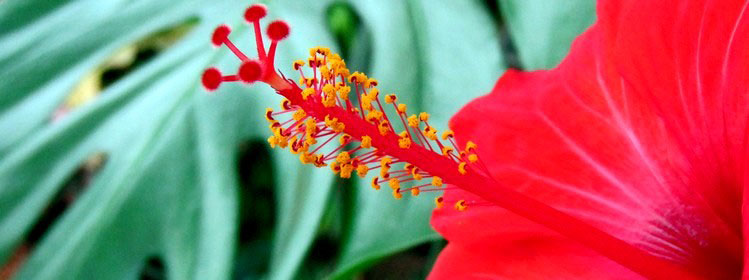

Here are some facts from the history of creation of our Winter garden. The first plants were set out as early as in 70s of the past century.
The garden, just as the hotel, was created for reception of the former Soviet Union government delegations.
Today we invite everyone who loves and appreciates green blooming fragrant plants, whose magnificent view and wide variety will cause great joy for you.
A date-palm has a preponderant position. It is a long-liver of our winter garden, it formed a mighty inclined trunk of 60 cm in diameter and a lot of pinnate glaucous leaves to 5 meters long. In its habitat — North Africa — this species lives up to 200 years, rising 30 m high and up to 75 cm in diameter of the trunk.
At the heart of the Winter garden there are hibiscuses known colloquially as China rose, a flower of love. They are in the mallow family, Malvaceae. A habitat is India, China. It is a widespread flowering plant with dark-green shiny leaves and showy fiery flowers.
The winter garden has been filled up with a wide variety of ficuses. Along with a Ficus elastica — well known indoor plant, there are many other exotic species of ficuses. It is a tree in the family Moraceae. It was imported from India. There it rises to a huge size, representing twiggy trees with thick trucks casting a long shadow.
Monstera deliciosa is a creeping vine of the family Araceae, native to tropical regions of the Americas. The plant is very resistant. It is original by its thick bent stem with a lot of aerial roots and lots of large, leathery, glossy, heart-shaped leaves often with holes in the leaf blade. Its edible fruit resembles a big cucumber and tastes like a combination of banana and pineapple. It takes 9 months to ripen. There are also other vines such as philodendron, bougainvillea, tetrastigma, ivy, asparagus.
Another exotic plant is a pawpaw. It is native to the tropics of the Americas. It is a large tree-like plant, with a single stem growing from 5 to 10 metres tall, with spirally arranged beautiful delicate light-green leaves confined to the top of the trunk. Its fruit shape and taste resemble a melon. Pawpaw is used as food and is exported to other countries. It is considered to be an elixir of life.
Strelitzia reginae is an exotic plant in the family Strelitziaceae indigenous to Cape Province (South African Republic). It is a perennial plant to 2 m high with a short stem. Originally-shaped flowers have the appearance of a magical bird's head and beak and are much in demand on the world market.
Flowering plants in the family Bromeliaceae also have an exotic appearance. They have original shape and the foliage, which is the most widely patterned and colored of any plant in the world. Their inflorescence is enduring and very spectacular.
Straight-stemmed and multicoloured dracaenas and cordylines are very attractive and smart-looking. They are nice plants with slender stems and leather-like leaves, which are clustered at the tips of the branches. They are native in tropical and subtropical Asia and Europe.
A fern is one of the ancient plants. It is widespread in the wet tropical areas. Their main merits are an original beauty, elegance and diversity. A black maidenhair fern attracts one’s attention with thin black glossy petioles resembling hair, and bright green, often delicately-cut leaf tissue resembling women’s curls.
Agave americana is distinguished among Succulent plants by spreading rosette of thick gray-green long leaves with needles resembling an octopus.
Nolinas are also attractive with their rosettes of thin flexible leaves on thick funny trunks. The plant is commonly called «ponytail palm» or «bottle tree».





